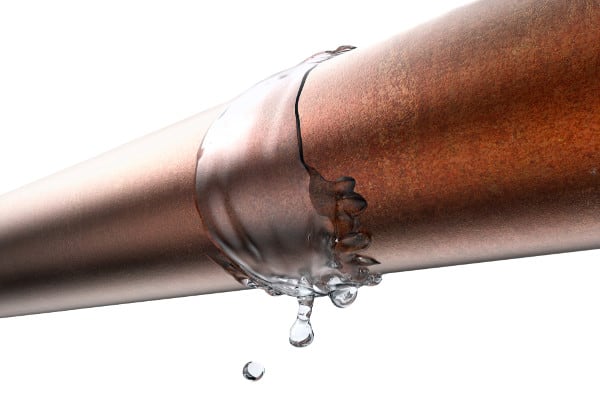Hydrostatic tests ensure the integrity of a system—and the right pump depends on system size, specs, and how quickly you want to achieve pressure
Hydrostatic tests of a sprinkler or standpipe system are designed to spot leaks in a closed piping system and ensure that a set-up will function under pressure during a fire. A test pump is used to send pressurized water into the network at a specific pounds per square inch (PSI) rating for two hours. Assuming no visible leakage is spotted—or a drop in pressure indicates a hidden leak somewhere—the system integrity is verified and it’s good to go.
But when should a test be conducted on different systems? And which hydrostatic test pump should a professional fire safety contractor use to get the job done? In this QRFS blog, we explore the basics of hydrostatic testing of fire sprinklers and standpipes, plus provide some guidance on choosing a test pump that fits the bill.
Are you looking to purchase a hydrostatic test pump? QRFS carries the best pumps in the business, including the highly-portable and versatile Triple R Tru-Test and the more robust HT-90 and HT-89A.
If you know all there is to know about NFPA requirements for hydrostatic testing, you can skip to the section of this blog about choosing a pump.
When to hydrostatic test fire sprinkler systems
Commercial fire sprinkler systems must be hydrostatically tested prior to system acceptance and whenever a subsequent revision to a system is made that involves more than 20 sprinkler heads. The test pressure defaults to 200 psi, 50 PSI higher than the normal working pressure of a system when that is more than 150 PSI, or the shutoff pressure of any onsite fire pump (if present).
System acceptance testing:
From the 2022 Edition of NFPA 13
29.2.1.1 Unless permitted by 29.2.1.3 through 29.2.1.6, all piping and attached appurtenances subjected to system working pressure shall be hydrostatically tested at 200 psi (14 bar) and shall maintain that pressure without loss for 2 hours.
29.2.1.2 Loss shall be determined by a drop in gauge pressure or visual leakage.
29.2.1.3 Portions of systems normally subjected to system working pressures in excess of 150 psi (10 bar) shall be tested as described in 29.2.1.1, at a pressure of 50 psi (3.4 bar) in excess of system working pressure.
29.2.1.4 Where a fire pump is used for a system, the test pressure shall be determined using the shutoff pressure of the pump.
29.2.1.6* The test pressure shall be read from a gauge located at the low elevation point of the system or portion being tested. The pressures in piping at higher elevations shall be permitted to be less than 200 psi (14 bar) when accounting for elevation losses. Systems or portions of systems that can be isolated shall be permitted to be tested separately.
System modification testing:
From the 2022 Edition of NFPA 13
30.8.1 Modifications to existing piping systems shall require testing at system working pressure.
30.8.1.1 Where modification is made to an existing system affecting more than 20 sprinklers, the new portion shall be isolated and tested at not less than 200 psi (14 bar) for 2 hours.
30.8.1.2 Modifications that cannot be isolated, such as relocated drops, shall require testing at system working pressure.
Testing is done at the lowest access point in the system, which is often a fire department connection (FDC) in a commercial system or another access point near the system riser. Once the air is removed via the inspector’s test valve (where applicable) and the pressurized water is introduced, contractors should look for any leaks in visible portions of the system (pipes, joints, and fittings) while ensuring that gauges read within about +/- 5 PSI of the specified test pressure. A significant drop in pressure either indicates a faulty gauge, a faulty pump, or a problem with system integrity somewhere.
Residential fire sprinkler systems must only be hydrostatically tested prior to acceptance at the system’s working pressure, according to NFPA 13D—unless a system has a fire department pumper connection, which means the test will have to follow the guidelines for commercial systems.
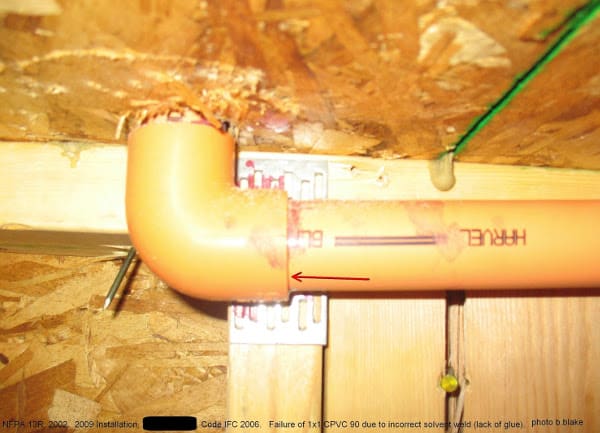
Of the above image, Fire Protection Deficiencies (which you should seriously bookmark, as it’s an awesome site) asks the key questions: “One question to ask is how this assembly passed the NFPA 13(R)* required hydrostatic pressure test. Another question to ask is was the required hydrostatic test conducted?”
For a more in-depth look at hydrostatically testing fire sprinklers, including special considerations such as cold-weather and pre-completion construction testing, read our previous blog: “What is a Hydrostatic Test of a Building’s Fire Protection System?”
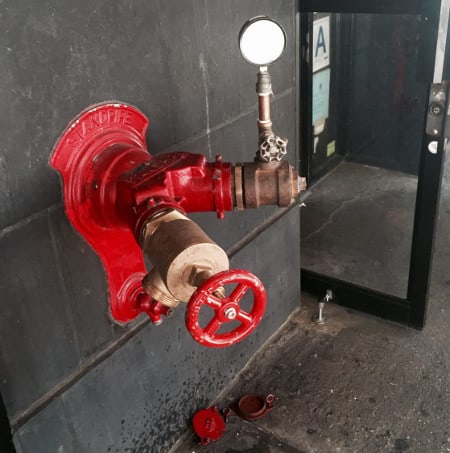
When to hydrostatic test standpipe systems
The hydrostatic testing requirements on standpipe systems are a bit more stringent. Testing must be done prior to system acceptance for all types of standpipes—manual wet, automatic wet, automatic dry, manual dry, and semi-automatic dry, including acceptance testing of underground pipe—and certain systems must be fully hydrostatically tested every five years. These include:
- Manual wet standpipes that are not part of a combined sprinkler/standpipe system
- Manual dry standpipes
- Semi-automatic dry standpipes
From the 2023 Edition of NFPA 25
6.3.2.1* Hydrostatic tests of not less than 200 psi (13.8 bar) pressure for 2 hours, or at 50 psi (3.4 bar) in excess of the maximum pressure, where maximum pressure is in excess of 150 psi (10.3 bar), shall be conducted every 5 years on manual standpipe systems and semiautomatic dry standpipe systems, including piping in the fire department connection.
6.3.2.1.1 Manual wet standpipes that are part of a combined sprinkler/standpipe system shall not be required to be tested in accordance with 6.3.2.1.
The other types of standpipe systems don’t need to be five-year tested because it’s assumed that leaks would be apparent since they always have pressurized water or gases in the pipe. But there is some confusion over whether NFPA 25 requires the unpressurized pipe that leads to the fire department connection to be tested in all systems. SprinklerAge examined this issue years ago and determined that a literal interpretation of the code means only testing the three types specified:
Is it the intent to not test that portion of the piping on those three standpipes that are otherwise excluded in the standard? Apparently, the answer is yes; it is specific to just those three identified. That clause of the sentence in the code reference is not meant to be a global requirement for all systems, but is a reminder that the portion of pipe between the check valve and the FDC must also be checked. It is, however, a good question as to why we aren’t required to test this portion of piping in all system types.
Again, the test is done from the low point in the system, usually the fire department connection, and the inspector(s) alternately watches pressure gauges for a significant drop and examines the pipe and fittings for leaks.
How to pick a hydrostatic test pump for fire sprinklers and standpipes
There are a number of test pumps at different specifications that can get the job done when it comes to hydrostatic testing. But the two most basic requirements are how much pump you need— in terms of PSI and gallons per minute (GPM)—as well as the power source of the pump (gas, electric, drill-powered, or hand pump).
Most standard hydrostatic test pumps are electric, though gas-powered pumps are often used in applications where you require more horsepower to move more water, faster. As long as a pump can hit the 200 PSI or +50 PSI in excess of systems with a maximum working pressure above 150 PSI, it can get the job done. Triple R puts it this way:
Even though pressure is important, in reality the (GPM) will determine how long it will take to get the job done. Since most tests are done at 200 psi or less, having a higher GPM will save time and money. A pump that is rated for 2.0 GPM @ max pressure of 500 PSI will take more than twice the time to do the job of a pump rated for 4.5 GPM @ max pressure of 400 PSI.
Other factors that determine how long a job will take and how much pump you need include:
- The diameter and length of the pipe in a closed system; a big standpipe is obviously going to take longer to hit test pressure than a small residential sprinkler system.
- The nature of a system and whether you are adding pressure to existing or already-pressurized water. It’s going to take a little longer, of course, to fill and pressurize an empty manual dry standpipe vs. a manual wet standpipe. Similarly, a wet sprinkler that has revised 20+ sprinklers and is fed off of a city water supply may naturally already have roughly 50-80 PSI of pressure.
- The size and especially the height of the building (because: gravity). This is why NFPA specifies running the test at a low point in the system, and why the test pressure should also be checked at high points in the system. That said, NFPA 13 allows the “pressures in piping at higher elevations … to be less than 200 psi (13.8 bar) when accounting for elevation losses” (29.2.1.6*)—but this of course involves calculating what those elevation/pressure losses should be.
Most test pumps specifically designed for fire safety hydrostatic testing can get the job done. Once you’ve selected a PSI and GPM combo that works for how quickly you’d like to achieve test pressure, the choice then comes down to a pump’s specific features.
Again, gas pumps are typically used for bigger jobs with bigger pipes—say, a couple thousand feet of pipe that is six inches in diameter— such as a standpipe test in a larger building.
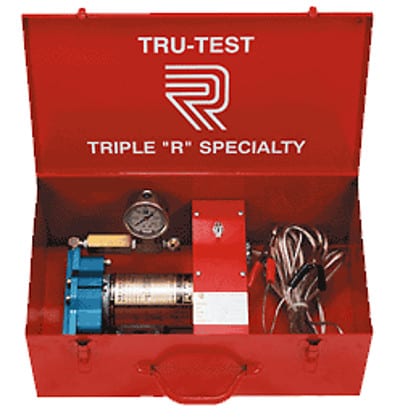
Electric pumps are incredibly popular because it’s more convenient to simply plug them in vs. dealing with fuel, and there are no fumes if they are used in indoor or otherwise enclosed settings. One of the most popular pumps sold by QRFS is the Triple R Tru-Test, a small-yet-powerful pump that can be purchased with either 120 Volt or 12 Volt power hook-ups, meaning you can either plug one into a standard electrical socket or run it off of a car battery.
The latter power source can be extremely handy for an installer or ITM contractor who is doing acceptance testing on a sprinkler system in an unfinished home without a working power supply, for example. Plumbers also use it for the hydrostatic acceptance testing of plumbing set-ups required by some local governments.
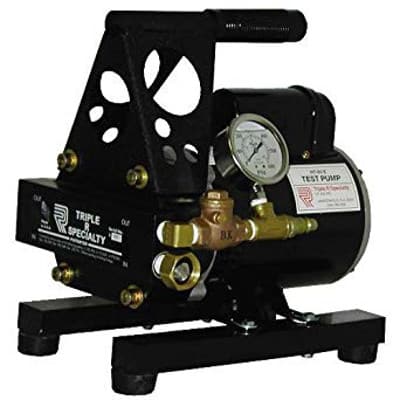
Another popular pump is the HT-90E, which is a bit bigger and moves more water (3.0 GPM vs. 2.2) yet remains light enough (32 lbs.) to easily move around on any job site. Some professionals choose the HT-89A, which is nearly identical to the 90E, except it has a pressure regulator. Pumps without these devices must be closely monitored to make sure they don’t go over the intended test pressure. But you can pre-set the desired PSI on an HT-89A and a bypass acts as a fail-safe to make sure the pressure doesn’t build beyond that setting.
Other desirable features include having quick-disconnect hoses; lighter, corrosion-resistant brass vs. cast iron or galvanized steel piping; a liquid-filled gauge; and one of the key benefits of Triple R pumps: they use lightweight aluminum and the pump is actually attached directly to the face of the motor. This means they don’t have the shaft that is seen in many older pumps—which means fewer moving parts, less maintenance, and lighter weight.
Basically, any pump that tips the scales at over 40 lbs. such as …
- The Rice EL1 hydrostatic test pump at 58 lbs.
- The Rice EL1A hydrostatic pump at 74 lbs.
- The Rice EL2 hydrostatic pump at 85 lbs.
… is going to be a beast to carry around.
For more information on the features of our hydrostatic test pumps, stay tuned for our pending blog that goes into even greater detail.
In the meantime, check out the specs of all of our in-stock fire pumps, including the Tru-Test, HT-89A, and HT-90E.
For any other Triple R pump you may be interested in, or to find out more information about pumps or hydrostatic testing, give us a call at 888.392.3362, email support@qrfs.com, or fill out our contact form.
This blog was originally posted at QRFS.com/blog. If this article helped you, check us out at Facebook.com/QuickResponseFireSupply or Twitter @QuickResponseFS.


